AUDI A6 2012 Owners Manual
Manufacturer: AUDI, Model Year: 2012, Model line: A6, Model: AUDI A6 2012Pages: 298, PDF Size: 74.43 MB
Page 251 of 298
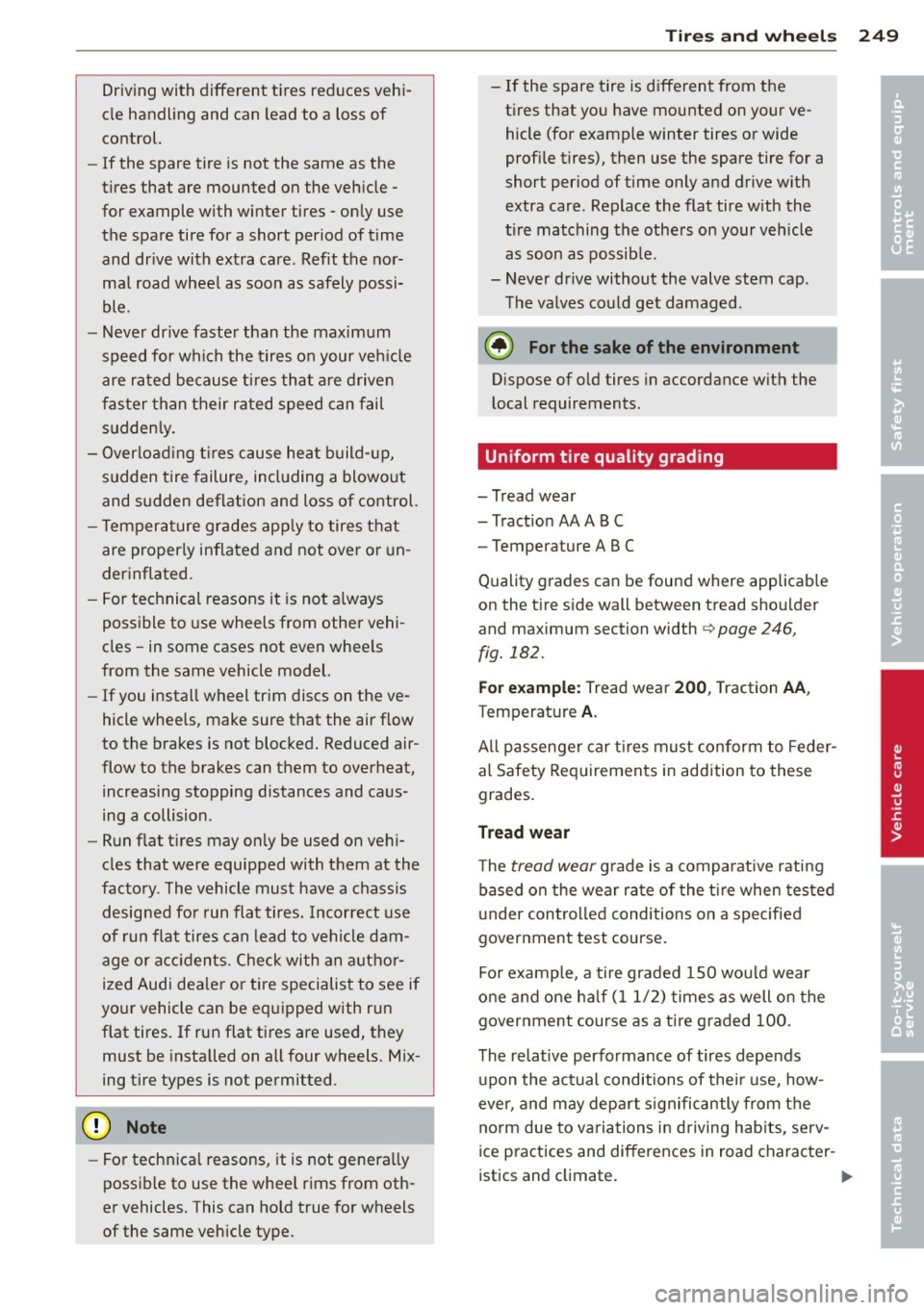
Driving with different tires reduces vehi
cle handling and can lead to a loss of
control.
- If the spare tire is not the same as the
tires that are mounted on the vehicle -
for example with winter tires -only use
the spare tire for a short period of time
and drive with extra care. Refit the nor
mal road wheel as soon as safely possi
ble.
- Never drive faster than the maximum
speed for which the tires on your vehicle
are rated because tires that are driven
faster than their rated speed can fail
suddenly.
- Overloading tires cause heat build-up,
sudden tire failure, including a blowout
and sudden deflation and loss of control.
- Temperature grades apply to tires that
are properly inflated and not over or un
deri nflated.
- For technical reasons it is not always
possible to use wheels from other vehi
des -in some cases not even wheels
from the same vehicle model.
- If you install wheel trim discs on the ve
hicle wheels, make sure that the air flow
to the brakes is not blocked. Reduced air
flow to the brakes can them to overheat, increasing stopping distances and caus
ing a collision.
- Run flat tires may only be used on vehi
cles that were equipped with them at the
factory. The vehicle must have a chassis designed for run flat tires . Incorrect use
of run flat tires can lead to vehicle dam
age or accidents. Check with an author
ized Audi dealer or tire specialist to see if
your vehicle can be equipped with run flat tires. If run flat tires are used, they
must be installed on all four wheels. Mix
ing tire types is not permitted.
- For technical reasons, it is not generally
possible to use the wheel rims from oth
er vehicles. This can hold true for wheels
of the same vehicle type.
Tires and wheels 249
- If the spare tire is different from the
tires that you have mounted on your ve
hicle (for example winter tires or wide
profile tires), then use the spare tire for a
short period of time only and drive with
extra care. Replace the flat tire with the
tire matching the others on your vehicle
as soon as possible .
- Never drive without the valve stem cap .
The valves could get damaged.
@) For the sake of the environment
Dispose of old tires in accordance with the
local requirements.
' Uniform tire quality grading
-Tread wear
- Traction AA A B C
- Temperature ABC
Quality grades can be found where applicable
on the tire side wall between tread shoulder
and maximum section width
c:> page 246,
fig. 182.
For example: Tread wear 200, Traction AA,
Temperature A.
All passenger car tires must conform to Feder
al Safety Requirements in addition to these
grades.
Tread wear
The tread wear grade is a comparative rating
based on the wear rate of the tire when tested
under controlled conditions on a specified
government test course.
For example, a tire graded 1S0 would wear
one and one half (11/2) times as well on the
government course as a tire graded 100.
The relative performance of tires depends
upon the actual conditions of their use, how
ever, and may depart significantly from the
norm due to variations in driving habits, serv
ice practices and differences in road character-
istics and climate. .,.. •
•
Page 252 of 298
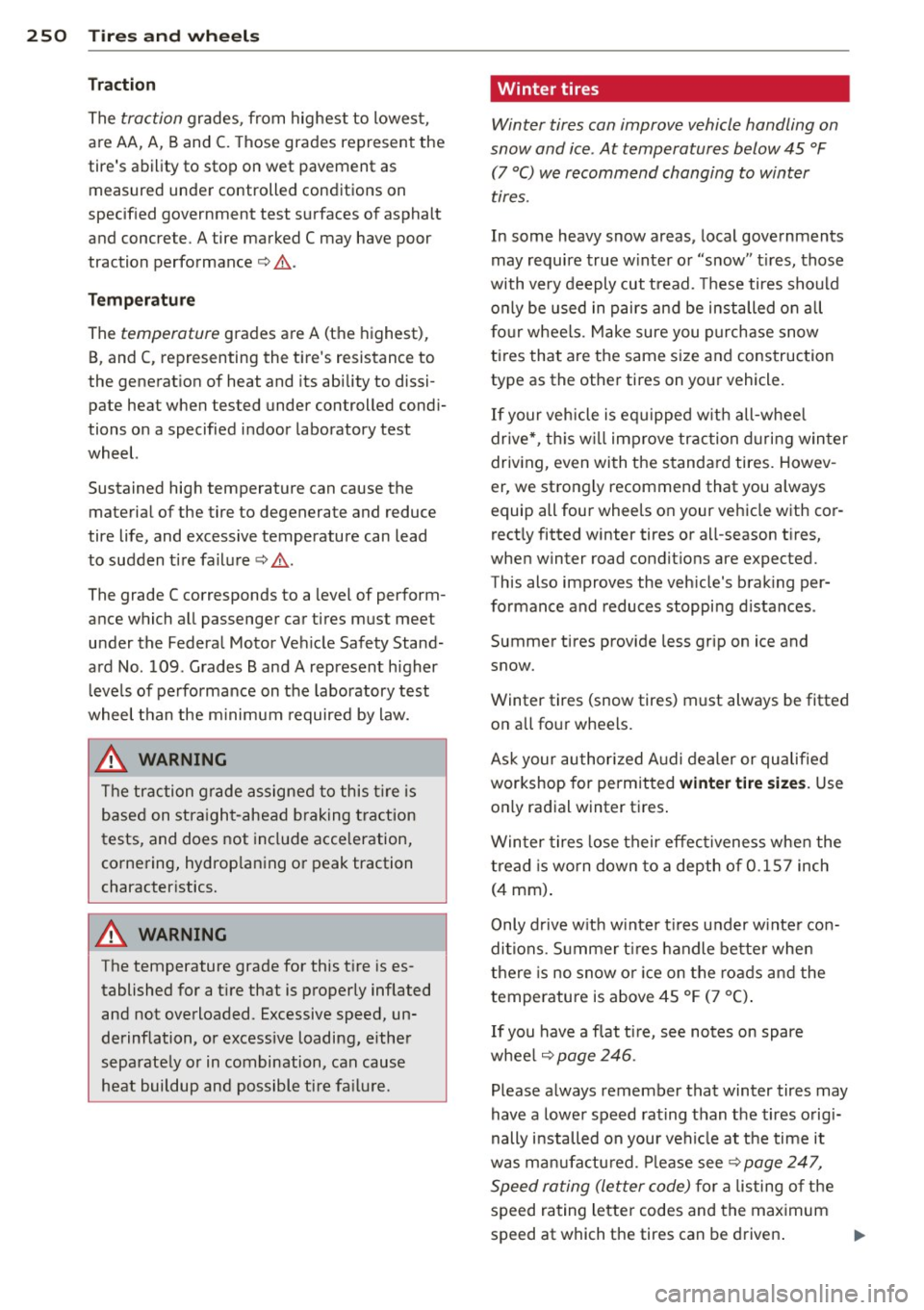
250 Tire s and wheel s
Traction
The traction grades, from highest to lowest,
are AA, A, Band
C. T hose grades represent the
tire's ability to stop on wet pavement as measured under controlled conditions on
specified government test surfaces of asphalt
and concrete. A tire marked C may have poor
traction performance
c:> .&. .
Te mp eratu re
The temperature grades are A (the highest),
B, and
C, representing the t ire's resistance to
the generat ion of heat and its ability to dissi
pate heat when tested under con trolled cond i
tions on a specified i ndoor laboratory test
wheel.
Sustained high temperature can cause the
material of the tire to degenerate and reduce
tire life, and excessive temperature can lead
to sudden tire failure
c:> ,& .
The grade C corresponds to a level of perform
ance which all passenger car tires must meet under the Federa l Motor Veh icle Safety Stand
ard No .
109 . Grades Band A represent h igher
l eve ls of pe rformance on the laboratory test
wheel than the m inimum required by law.
.&_ WARNING
T he traction grade assigned to this t ire is
based on stra ight-ahead braking traction
tests, and does not include acceleration,
cornering, hydrop laning o r peak traction
character istics.
A WARNING
The temperature grade for this t ire is es
tablished for a t ire that is properly inflated
and not ove rloaded. Excessive speed, un
derinflation, or excessive loading, either
separately or in combination, can cause
heat buildup and possible ti re fa ilu re.
-
Winter tires
Winter tires can improve vehicle handling on
snow and ice . At temperatures below 45 °F
(7 °C) we recommend changing to winter
tires.
In some heavy snow areas, local governments
may require true w inter o r "snow" t ires , those
with very deeply cut tread . Th ese tires should
o n ly be used in pairs and be installed on a ll
f o ur wheels . Make sure you p urch ase snow
t ir es that are the same size and cons truction
type as the othe r tires on yo ur vehicle.
If your vehicle i s equ ipped w ith all-whee l
drive*, t his w ill improve tr action d uring win ter
driv ing, even with the standard tires . Howev
er, we strongly recommend that you always
equip all four wheels on your vehicle w ith cor
rect ly fitted winter tires or all-season t ires,
when winter road condit ions are expected.
This also improves the veh icle 's brak ing per
formance and reduces stopping d istances .
Summer tires provide less grip on ice and
snow.
Winter tires (snow tires) must always be fitted on all fo ur whee ls .
As k your au thori zed A udi dealer or qualified
workshop for permit ted
winter tire size s. Use
only radial winter tires .
Winter tires lose their effec tivenes s whe n the
tread is wo rn down to a depth o f
0.1 57 inch
(4 mm) .
Only d rive w ith w inter t ires under w inte r co n
di tions. S umme r tir es handle be tte r whe n
the re is no snow o r ice on the roa ds and the
temperatu re is above 45 °F (7 °C) .
If you have a flat ti re, see notes on spare
whee l
c:> page 246 .
Please always remember that winter tires may
have a lowe r speed rating than the tires o rigi
nally i nstalled on your vehi cle at the time it
was manuf actu red. P lease see
c:> page 247,
Speed ra ting (Letter code)
fo r a lis ting o f the
speed rating lette r codes and the max imum
speed at which the tires can be driven . ..,.
Page 253 of 298
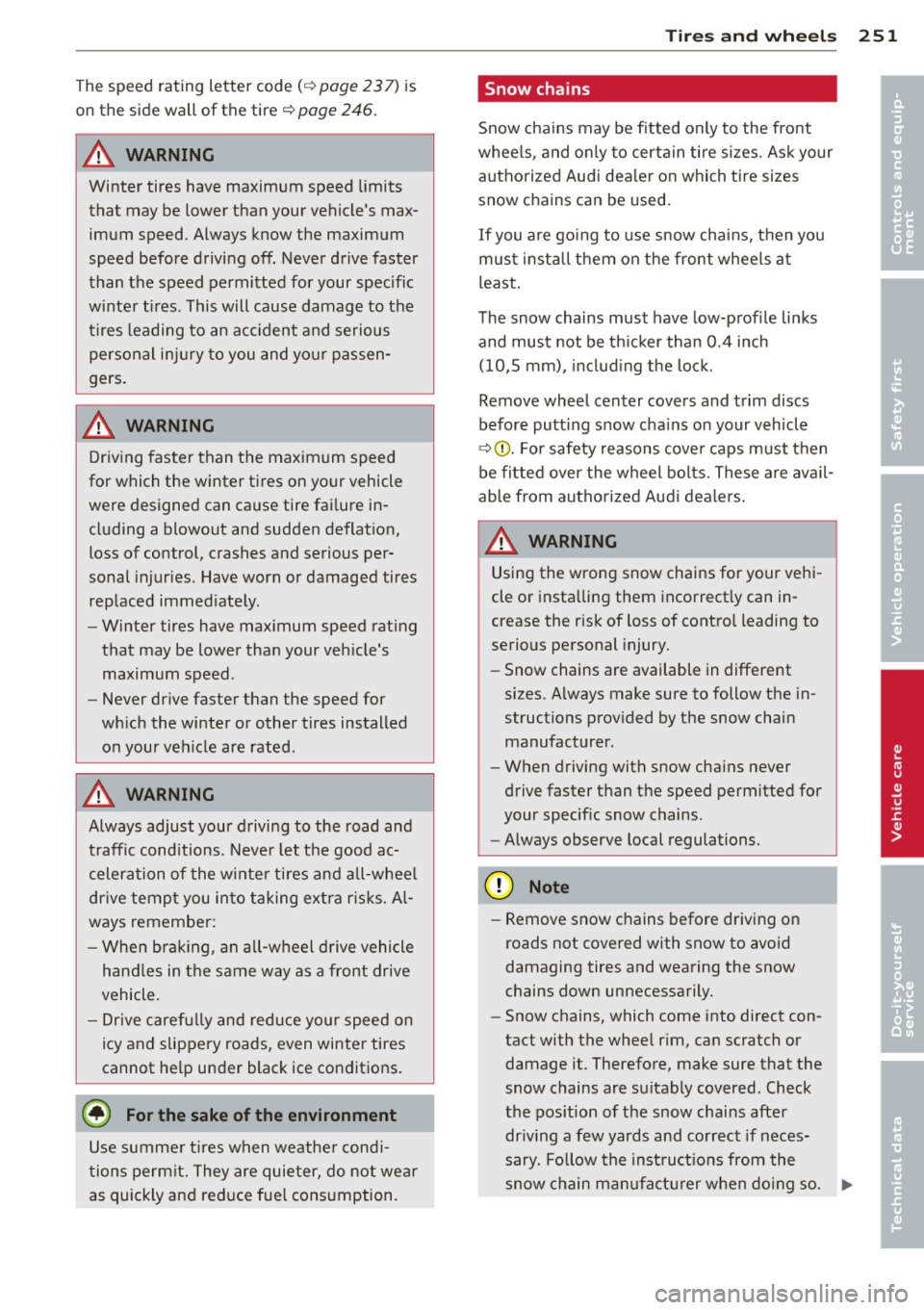
The speed rating letter code (c::> page 23 7) is
on the side wall of the tire
c::> page 246.
A WARNING
Winter tires have maximum speed limits
that may be lower than your vehicle's max
imum speed . Always know the maximum
speed before driving off. Never drive faster
than the speed permitted for your specific
winter tires . This will cause damage to the
tires leading to an accident and serious
personal injury to you and your passen
gers.
A WARNING
Driving faster than the maximum speed
for which the winter tires on your vehicle
were designed can cause tire failure in cluding a blowout and sudden deflation,
loss of control, crashes and serious per
sonal injuries . Have worn or damaged tires
replaced immediately.
- Winter tires have maximum speed rating
that may be lower than your vehicle's
maximum speed .
- Never drive faster than the speed for
which the winter or other tires installed
on your vehicle are rated .
A WARNING
Always adjust your driving to the road and
traffic conditions. Never let the good ac
celeration of the winter tires and all-wheel
drive tempt you into taking extra risks . Al
ways remember :
- When braking, an all-wheel drive vehicle
handles in the same way as a front drive
vehicle.
- Drive carefully and reduce your speed on
icy and slippery roads, even winter tires
cannot help under black ice conditions.
@l For the sake of the environment
Use summer tires when weather condi
tions permit. They are quieter, do not wear
as quickly and reduce fuel consumption.
-
Tires and wheels
Snow chains
Snow chains may be fitted only to the front
wheels , and only to certain tire sizes. Ask your
authorized Audi dealer on which tire sizes
snow chains can be used.
If you are going to use snow chains, then you
must install them on the front wheels at
least.
The snow chains must have low-profile links
and must not be thicker than 0.4 inch
(10,S mm) , including the lock.
Remove wheel center covers and trim discs
before putting snow chains on your vehicle
c::> (]) . For safety reasons cover caps must then
be fitted over the wheel bolts. These are avail
able from authorized Audi dealers.
A WARNING ,..__
Using the wrong snow chains for your vehi
cle or installing them incorrectly can in
crease the risk of loss of control leading to
serious personal injury.
- Snow chains are available in different
sizes . Always make sure to follow the in
structions provided by the snow chain manufacturer .
- When driving with snow chains never
drive faster than the speed permitted for
your specific snow chains .
- Always observe local regulations.
(D Note
- Remove snow chains before driving on
roads not covered with snow to avoid
damaging tires and wearing the snow
chains down unnecessarily.
- Snow chains, which come into direct con
tact with the wheel rim, can scratch or
damage it. Therefore, make sure that the
snow chains are suitably covered . Check
the position of the snow chains after
driving a few yards and correct if neces
sary. Follow the instructions from the
snow chain manufacturer when doing so. ..,.
251
•
•
Page 254 of 298
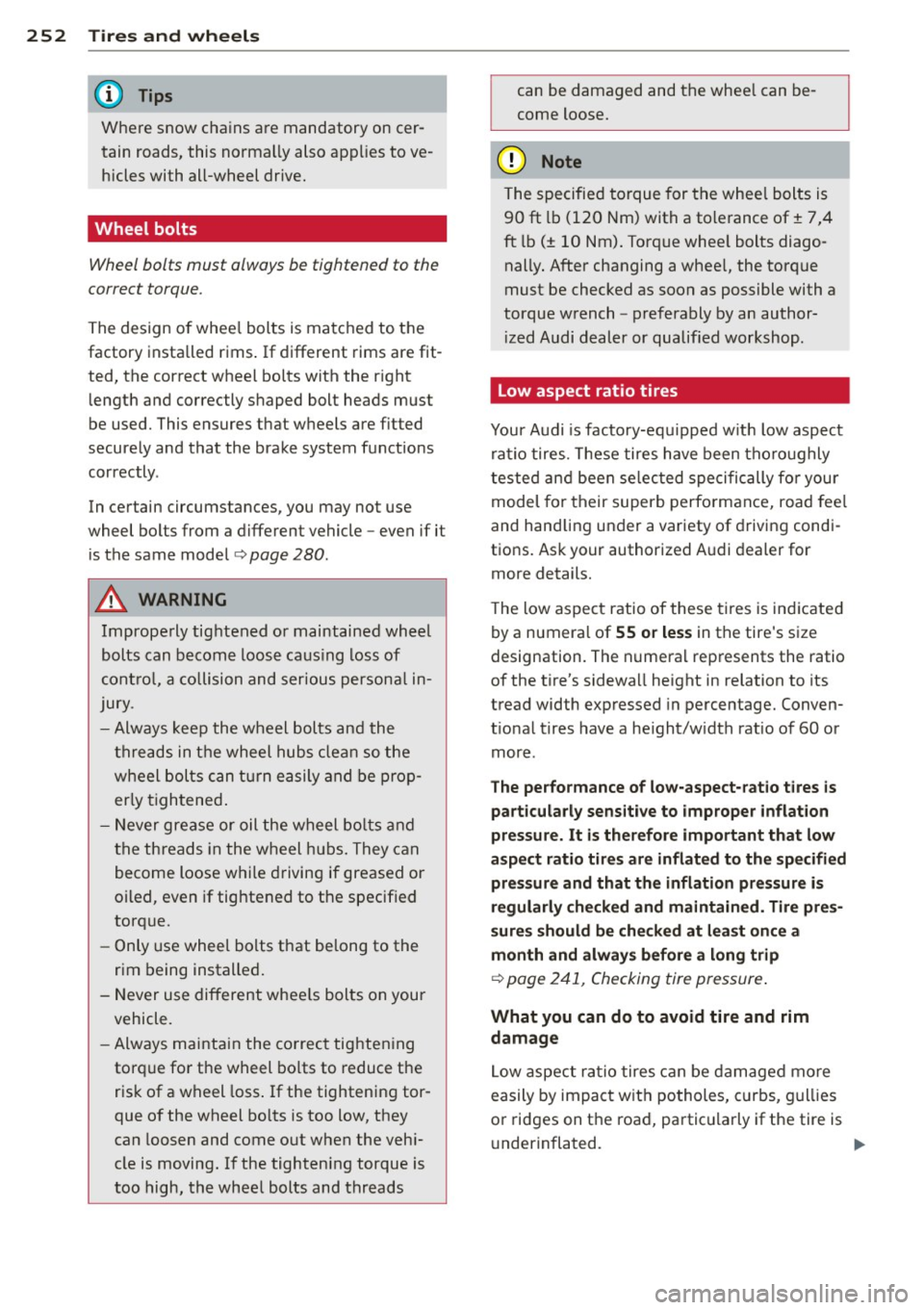
252 Tire s and wheel s
Where snow chains are mandatory oncer
tain roads, this normally also applies to ve
hicles with all-wheel drive.
Wheel bolts
Wheel bolts must always be tightened to the
correct torque .
The design of whee l bolts is matched to the
factory insta lled rims . If different rims are fit
ted, the correct wheel bolts with the r ight
length and correctly shaped bolt heads must
be used. This ensures that wheels are fitted
securely and that the brake system functions
correctly .
In certain circumstances, you may not use
wheel bolts from a different vehicle -even if it
is the same model
r=> page 280.
A WARNING
Imprope rly tightened o r maintained wheel
bolts can becom e loose ca using loss of
c ont ro l, a co llision and serious persona l in
Jury .
- Always keep the w heel bolts an d the
threads in the wheel hubs clean so the
w heel bolts can turn easily and be p rop
er ly tigh tened .
- N ever grease or oil the wheel bo lt s an d
the threads in the w heel hubs. They can
become loose while d riving if greased or
oi led, even if tightened to the specified
torq ue.
- Only use wheel bolts that belong to the
rim being installed.
- N ever use different whee ls bolts on your
vehicle.
- Alw ays maintain the co rrec t tighten ing
torq ue fo r th e wheel bo lts to reduce the
risk of a wheel loss . If the tightening tor
que of the wheel bo lts is too low, they
can loosen and come out w hen the veh i
cle is moving. If the tighteni ng torque is
too high, the whee l bolts and threads can be damaged and the whee
l can be
come loose.
@ Note
The specified torque for the whee l bolts is
90 ft lb (120 Nm) with a tolerance of± 7,4
ft lb(± 10 Nm) . Torque whee l bolts diago
nally. After changing a whee l, the torque
must be checked as soon as possible with a
torque w rench -preferably by an author
i zed Audi dealer or qualified workshop .
Low aspect ratio tires
Your A udi is facto ry-eq uipped w it h low aspect
ra tio tires. These tires have been tho roughly
tested and been se lected specific ally fo r your
model fo r their superb perfo rmance, road fee l
and hand ling under a variety of d riving condi
t ions . Ask your author ized A udi dealer for
more details.
T he low aspect ratio of these tires is ind icated
by a numera l of
55 or less in the tire's s ize
designation. The n umera l represents the ratio
of the tire's sidewa ll height in relation to its
tread width expressed in percentage. Conven
t iona l tires have a he ight/w idth rat io of 60 or
more .
The performance of low-aspect -ratio tires is
particularly sens iti ve to imp roper inflation
pressure. It is therefore important that low
a spect ratio tires are inflated to the specified
pre ssure and that the inflation pressure i s
regularly ch ecked and maintain ed. Tire pre s·
sure s should be checked at lea st once a
month and always before a long trip
r=> page 241, Checking tire pressure .
What you can do to avoid tire and rim
damage
Low aspect ra tio tires can be d amage d more
easily by impact w it h potholes, curbs, g ull ies
or ridges on t he road, particularly if the tire is
u nd eri nflated.
Page 255 of 298
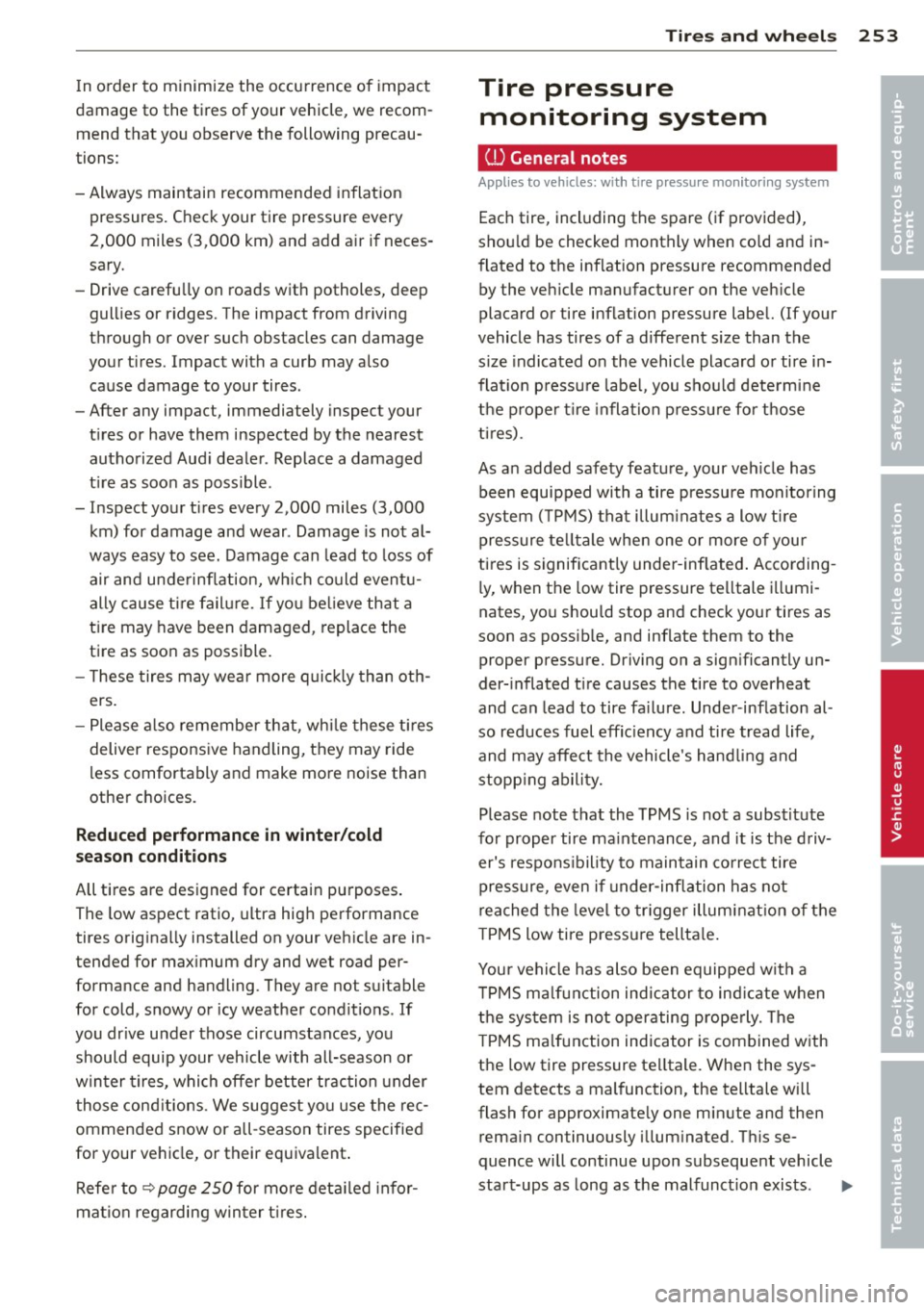
In o rder to minimize the occurrence o f impact
damage to the tires of your vehicle, we recom mend that you observe the following precau
tions :
- Always maintain recommended inflation
pressures. Check your tire pressure every
2,000 miles (3,000 km) and add a ir if neces
sary.
- Drive carefu lly on roads with potholes, deep
gullies or ridges. The impact from driving
through or over such obstacles can damage
your tires. Impact with a curb may also cause damage to your tires .
- After any impact, immediately inspect your
tires or have them inspected by the nearest
authorized Aud i dealer . Replace a damaged
t ire as soon as poss ible .
- In spect your t ires every 2,000 miles (3,000
km) for damage and wear . Damage is not al
ways easy to see. Damage can lead to loss of
air and unde rinflation, wh ic h could eventu
ally cause ti re fail ure.
If yo u be lieve that a
ti re may have been damaged , replace the
tire as soon as possible.
- These tires may wear more quick ly than oth
ers.
- Please a lso remembe r that, whi le these t ires
deliver respons ive handling, they may ride
less comfortably and make more noise than
other c hoices.
Reduced p erformance in winter /cold
s ea son condit ion s
All ti res are designed for certain purposes .
The low aspect ratio, ultra hig h performance
tires originally installed on your veh icle are in
tended for max imum dry and wet road per
formance and handling . They are not suitable
for cold, snowy or icy weather cond it ions . If
you dr ive under those circumstances, you
should equip your vehicle with all-season or
winter tires, whi ch offe r better traction under
those cond it ions . We suggest you use the rec
ommended snow or all -season tires specified
for your ve hicle, or their equiva lent .
Refe r to ~
page 250 for mo re deta iled info r
mat io n regarding w in ter t ires.
Tire s an d wheel s 253
Tire pressure
monitoring system
ill General notes
App lies to vehicles : wi th tire p ress ure mo nito rin g system
Each tire, incl uding the spare (if provided),
shou ld be checked monthly when co ld and in
flated to the inflation pressure recommended
by the veh icle manufacturer on the veh icle
placard or tire inflation pressure label. (If your
vehicle has tires of a d ifferent size than the
s iz e indicated on the vehicle placard or tire in
flat io n pressu re labe l, you shou ld dete rmine
the p roper t ire inflation p ress ure fo r those
t i r es).
As an added safety feature, your veh icle has
been equipped with a tire pressure monitoring
system ( TPMS) that illum inates a low ti re
pressure te lltale whe n one or more o f your
ti res is significant ly under -inflated . According
ly, when the low tire pressure te lltale i llumi
nates, you shou ld stop and check your tires as
soon as possib le, and inflate them to the
proper pressure. Driving on a sign ificantly un
der- inflated t ire causes the tire to overheat
and can lead to tire fa ilure . Under-inflation al
so reduces fuel effic iency and tire tread life,
and may affect the vehicle 's hand ling and
stopp ing abil ity.
Please note that the TPMS is not a subst itute
fo r proper tire ma intenanc e, and it is the d riv
er's respo nsibility to maintain co rrect tire
pressure, even if under-inflation has not
reached the leve l to tr igger illum inat ion of the
T PMS low ti re p ressu re tellta le .
You r vehicle has also been equipped with a
T PMS ma lf u nction indicator to ind icate w hen
the sys tem is not operating prope rly . T he
T PMS ma lfunction indicator is combined w ith
the low tire pressure te lltale. When the sys
tem detects a malfunction, the telltale wi ll
flash for approximate ly one min ute and then
rema in con tinuously i llum inated . T hi s se
quence will continue upon subsequent vehicle
start-ups as long as the malfunct ion exists . ..,.
•
•
Page 256 of 298

254 Tires and wheels
When the malfunction indicator is illuminat
ed, the system may not be able to detect or
signal low tire pressure as intended . TPMS
malfunctions may occur for a variety of rea
sons, including the installation of replace ment or alternate tires or wheels on the vehi
cle that prevent the TPMS from funct ioning
properly . Always check the TPMS malfunction
telltale after replacing one or more t ires or
wheels on your veh icle to ensure that the re
placement or alternate tires and wheels allow
the TPMS to continue to function properly.
Tire pressure indicator appears
Applies to vehicles: with tire p ressure mo nitoring syste m
The tire pressure indicator in the instrument
cluster informs you if the tire pressure is too
low or if there is a system malfunction.
Fig. 183 Display : underinflatio n warning
Fig. 184 Display : Syste m mal functio n
Using the ABS sensors, the tire pressure moni
toring system compares the tire tread circum
ference and vibration characteristics of the in
d ividual tires. If the pressure decreases in one
or more tires, th is is indicated in the instru
ment cluster with a warning symbol
'9] and a
message
<=>fig . 183.
The tire pressure monitoring system must be
reset via MMI each time the pressures are ad- justed
(e.g. when switching between partial
and full load pressure) or after changing or re
placing a tire on your vehicle <=>
page 255. You
can find the recommended tire pressures for
your vehicle on the label on driver' s side B-pil
lar
<=> page 239 .
Tire tread circumference and vibration charac
teristics can change and cause a tire pressure
warning if:
- the tire pressure in one or more tires is too
low,
- the tire has structural damage,
- the tire pressure was changed, wheels rotat -
ed or replaced but the TPMS was not reset
<=> page 255.
Warning symbols
'9] Loss of pressu re in at least one t ire r=> & .
Check the tire or tires and replace or repa ir if
necessary. The indicator light
'9] in the instru
ment cluster also illuminates
<=>page 12 .
Check/correct the pressures of all four tires
and reset TPMS via MMI.
••MIS, ( Ti re Pressure Monitoring System) Tire
pressure! System malfunction .
If IIMIS, appears after switching the ignition
on or while driving
r::!> fig. 184 and the indica
tor light
'9] in the instrument cluster blinks
f or approximately one minute and then stays
on, there is a system malfunction . See your
authorized Audi dealer as soon as possible .
A WARNING
--If the tire pressure indicator appears in
the instrument cluster display, one or more of your tires is significant ly under
inflated. Reduce your speed immediately
and avoid any hard steer ing or braking
maneuvers. Stop as soon as possible and
check the tires and their pressures. In
flate the tire pressure to the proper pres
sure as indicated on the vehicle's tire
pressure label
<=>page 239. Driving on a
significantly under- inflated tire causes
the tire to overheat and can lead to tire
failure. Under-inflation also is likely to
Page 257 of 298
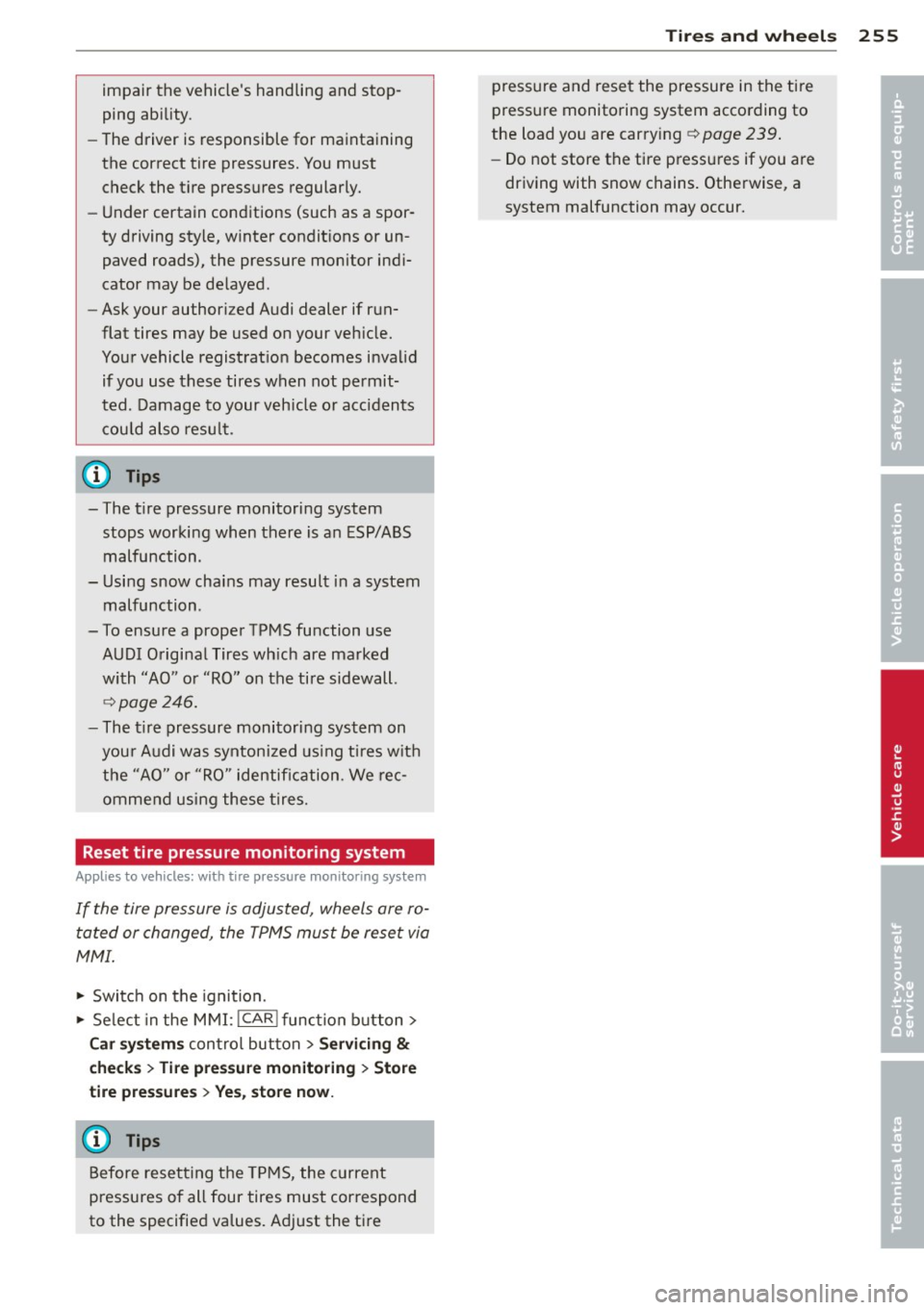
impair the vehicle's handling and stop
ping ability.
- The driver is responsible for maintaining
the correct tire pressures. You must
check the tire pressures regularly.
- Under certain conditions (such as a spor
ty driving style, winter conditions or un paved roads), the pressure monitor indi
cator may be delayed.
- Ask your authorized Audi dealer if run
flat tires may be used on your vehicle.
Your vehicle registration becomes invalid
if you use these tires when not permit
ted. Damage to your vehicle or accidents could also result.
(0 Tips
- The tire pressure monitoring system stops working when there is an ESP/ABS malfunction.
- Using snow chains may result in a system malfunction .
- To ensure a proper TPMS function use
AUDI Original Tires which are marked
with "AO" or "RO" on the tire sidewall.
¢page 246.
-The tire pressure monitoring system on
your Audi was syntonized using tires with
the "AO" or "RO " identification. We rec
ommend using these tires.
Reset tire pressure monitoring system
Applies to vehicles: with tire pressure monito ring system
If the tire pressure is adjusted, wheels are ro
tated or changed, the TPMS must be reset via
MMI.
"' Switch on the ignition.
"' Select in the MMI: !CAR !function button>
Car systems control button > Servicing &
checks > Tire pressure monitoring > Store
tire pressures> Yes, store now.
@ Tips
Before resetting the TPMS, the current
pressures of all four tires must correspond
to the specified values. Adjust the tire
Tires and wheels 255
pressure and reset the pressure in the tire
pressure monitoring system according to
the load you are carrying
c::!;> page 239.
- Do not store the tire pressures if you are
driving with snow chains. Otherwise , a
system malfunction may occur.
•
•
Page 258 of 298

256 What do I do now?
What do I do now?
Trunk escape handle
In case of an emergency, the rear lid can be
opened from the inside using the trunk es
cape handle.
Fig. 185 Trunk escape handle: View from inside the
close d trunk
To open rear lid
.. Pull the hand le down towards the bumper
r=;,fig. 185.
The trunk escape handle inside the rear lid is
made of fluorescent material to glow in the
dark.
A WARNING
The trunk escape handle is to be used only
in an emergency .
@ Tips
The emergency re lease lever shou ld never
be used as a handle for closing the rear lid.
Emergency warning
triangle
Applies to veh icles: w it h emergency wa rning tria ng le
The warning triangle is located on the inside
of the trunk lid.
Fig. 186 Trunk lid: Warn ing t riangle
.. To remove the warning triangle, press the
retainer in the direction of the arrow and
fold the holder down .
The rear lid is only designed to hold the warn
ing triang le offered by the original accessories
program. If you wou ld like to retrofit your ve
hicle with a warning triangle, please contact
your autho rized Audi dea ler.
Page 259 of 298
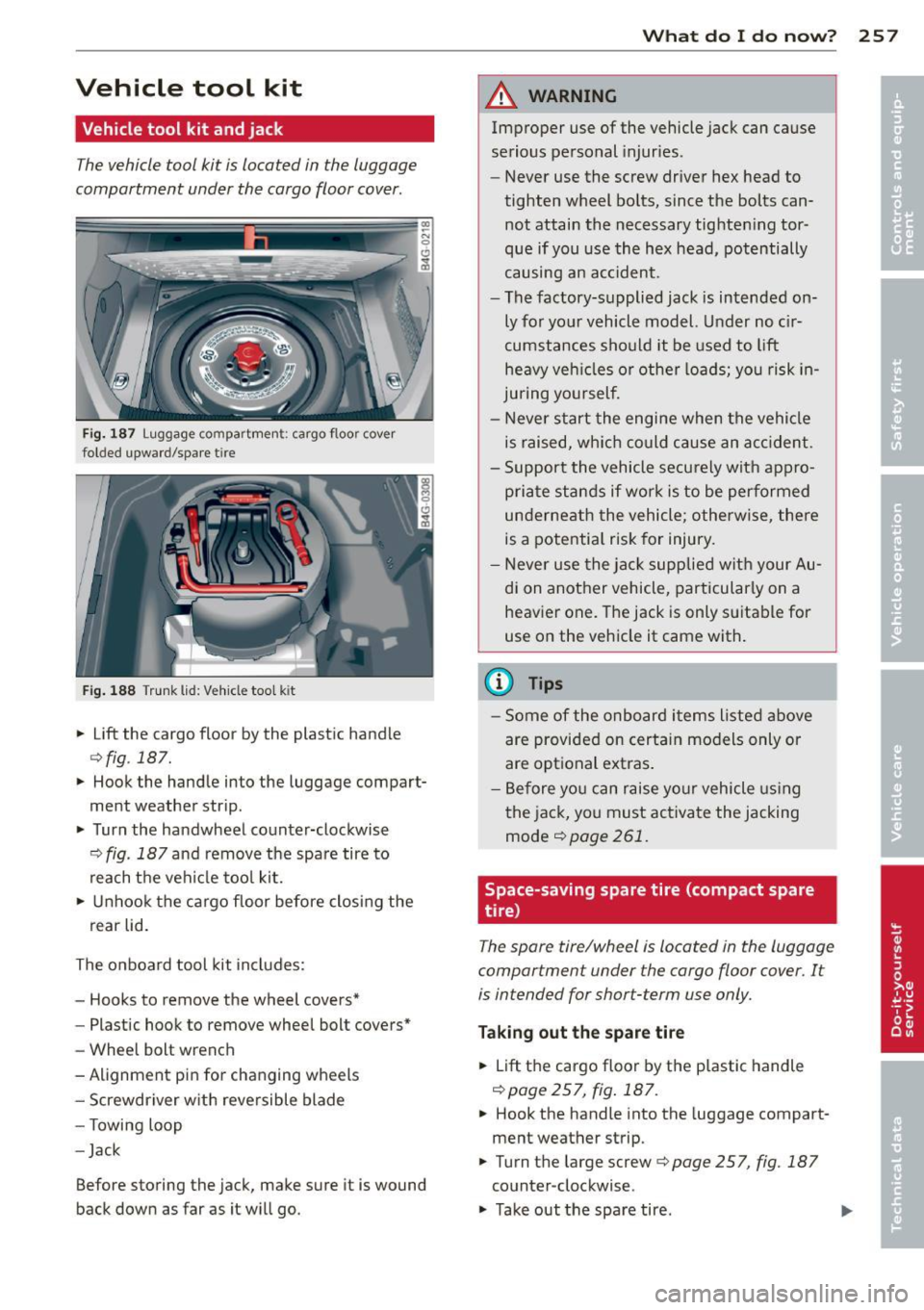
Vehicle tool kit
Vehicle tool kit and jack
The vehicle tool kit is located in the luggage
compartment under the cargo floor cover .
Fig. 187 Luggage co mpa rtmen t: ca rgo f loo r cover
fol ded upwar d/spare t ire
Fig . 188 Trunk lid : Vehicle too l ki t
.. Lift the cargo floo r by the plastic handle
c:> fig . 187.
.. Hook the handle in to the luggage compar t
ment weather strip .
.. Turn the handwheel counter-clockwise
c:> fig . 187 and remove the spare tire to
reach the vehicle too l kit.
.,. Unhook the ca rgo floor before closing the
rear lid.
The onboard tool kit includes:
- Hooks to remove the wheel covers*
- Plastic hook to remove wheel bolt covers*
- Wh eel bolt wrench
- Alignment pin for changing wheels
- Screwdriver w ith reversible blade
- T owing loop
- Jack
Before stor ing the jack, m ake sure it is wound
back down as far as it will go.
What do I d o now ? 257
A WARNING
Im proper use of the vehicle jack can cause
serious personal injur ies.
- Never use the screw driver hex head to
tighten wheel bolts, since the bolts can
not attain the necessary tighten ing tor
que if you use the hex head, potentially
causing an accident .
- The factory-supplied jack is intended on
ly for yo ur vehicle model. Under no c ir
cumstances should it be used to lift heavy veh icles or other loads; you risk in
ju ring yo urself.
- Never start the engine when the vehicle
is raised, wh ich could cause an acc ident.
- Support the vehicle securely with appro
priate stands if work is to be performed
underneath the vehicle; otherwise, there
is a potentia l risk for injury.
- Never use the jack supplied wit h your Au
di on another vehicle, particularly on a
heavier one. The jack is only s uitable for
use on the vehicle it came with.
(D Tips
- Some of the onboard items listed above
are provided on certain models only or
are optional ext ras .
- Before yo u can raise your vehicle using
the jack, you must activate the jacking
mode
c:!) page 261.
Space-saving spare tire (compact spare
tire )
The spare tire/wheel is located in the luggage
compartmen t under the cargo floor cover . It
is intended for short-term use only.
T a king out th e spare tir e
.. Lift t he cargo floor by the p lastic handle
<=) page 257, fig . 187 .
.. Hook the handle into the luggage compart
ment weather strip.
.. Turn the large screw ¢
page 257, fig. 187
counter-clockwise .
.,. Take out the spare tire .
Page 260 of 298
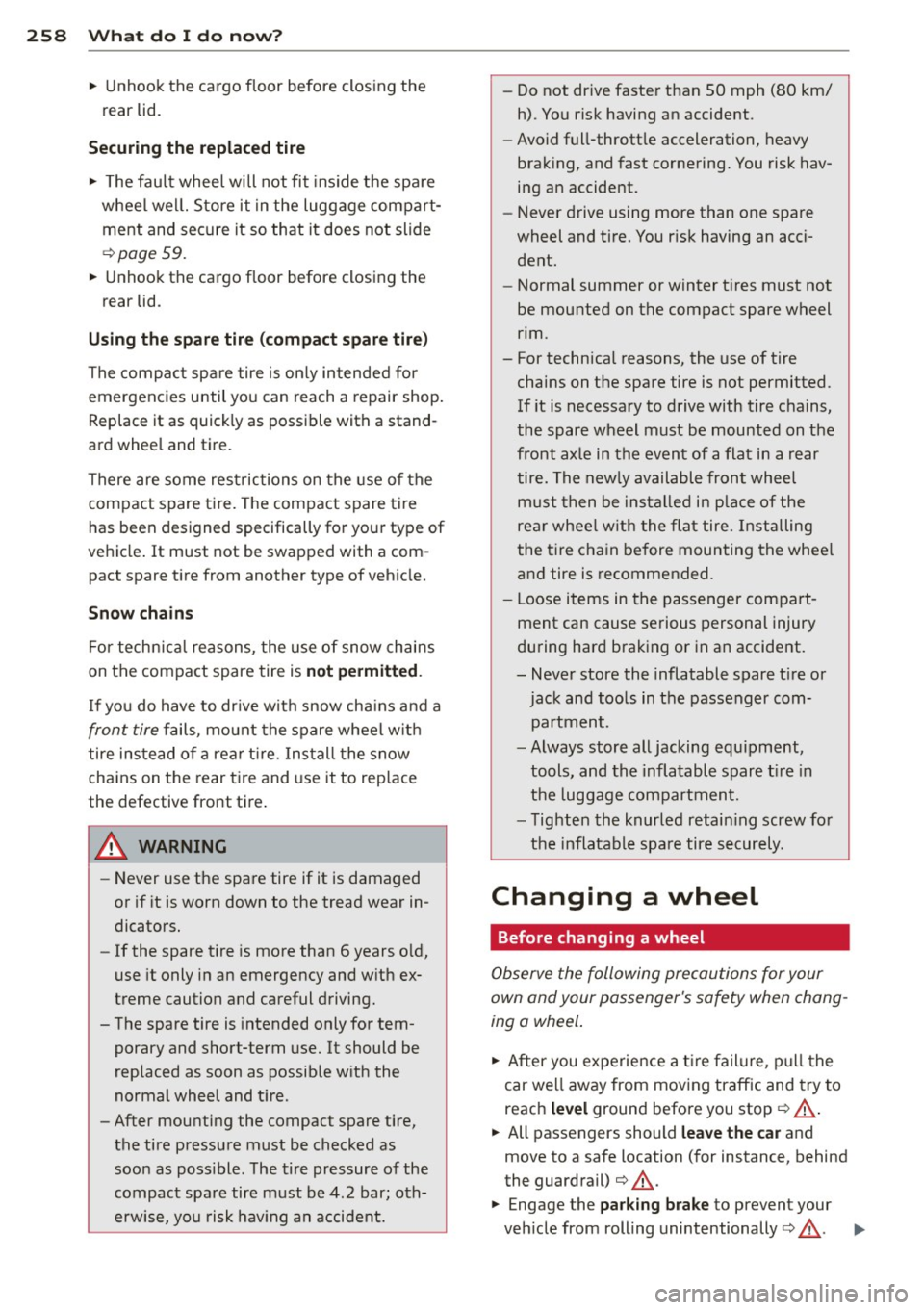
258 What do I do no w?
• Unhook the ca rgo floor before closing the
rear lid.
Securing the replaced tire
• The fault whee l will not fit inside the spare
wheel wel l. Sto re it in the luggage compart
ment and sec ure it so that it does not slide
¢ page 59.
• Unhook the cargo floor before closing the
rear lid.
U sing the spar e tire (compact spare tir e)
The compact spare tire is on ly intended for
emergencies until you can reach a repair shop.
Replace it as quickly as possible with a stand
ard wheel and tire.
There are some restrictions on the use of the
compact spare tire. The compact spare tire
has been designed specifically for your type of
vehicle. It must not be swapped with a com pact spare t ire from another type of veh icle.
Snow chain s
For technical reasons, the use of snow chains
on the compact spare tire is not permitt ed .
I f you do have to dr ive w ith snow cha ins and a
front tire fails, mo unt the spare wheel w ith
tire instead of a rear t ire. Install the snow
cha ins on the rear tire and use it to rep lace
the defective front tire .
A WARNING
-Never use the spare tire if it is damaged
or if it is worn down to the tread wear in
dicators.
- If the spare tire is more than 6 years o ld,
use it only in an emergency and w ith ex
treme caution and careful driving.
- The spare tire is intended only for tem
porary and short-term use. It should be
replaced as soon as possible w ith the
normal wheel and t ire.
- After mounting the compact spare tire,
the tire pressure must be checked as
soon as poss ible. The tire pressure of the
compact spare tire must be 4.2 bar; oth
erwise, you risk hav ing an accident. -
Do not drive faster than 50 mph (80 km/
h). Yo u risk having an accident.
- Avoid full-thrott le acceleration, heavy
braking, and fast cornering. You risk hav
ing an accident.
- Never drive using more than one spare
wheel and tire. You r isk having an acci
dent.
- Normal summer or winter tires must not
be mounted on the compact spare wheel
rim.
- For technical reasons, the use of tire
chains on the spare tire is not permitted.
If it is necessary to drive with tire chains,
the spare wheel must be mounted on the
front ax le in the event of a flat in a rear
tire. The new ly available front wheel
m ust then be instal led in place of the
rear whee l w ith the flat tire. Installing
the tire chain be fore mounting the whee l
and tire is recommended.
- Loose items in the passenger compart
ment can cause serious personal injury
during hard brak ing or in an accident.
- Never store the inflatable spare t ire or
jack and too ls in the passenger com
partment.
- Always store all jacking equipment,
tools, and the inflatable spare t ire in
the luggage compartment.
- Tighten the knurled retai ning screw for
the inflatable spare tire securely .
Changing a wheel
Before changing a wheel
Observe the following precautions for your
own and your passenger's safety when chang
ing a wheel .
• After you experience a t ire failure, pu ll the
car we ll away from moving traffic and try to
reach level ground before you stop
¢ ,& .
• All passengers should lea ve the car and
move to a safe location (for instance, behind
the guardrail)¢ ,&.
• Engage the parking brake to prevent your
veh icle from rolling unintentionally¢,& . ..,